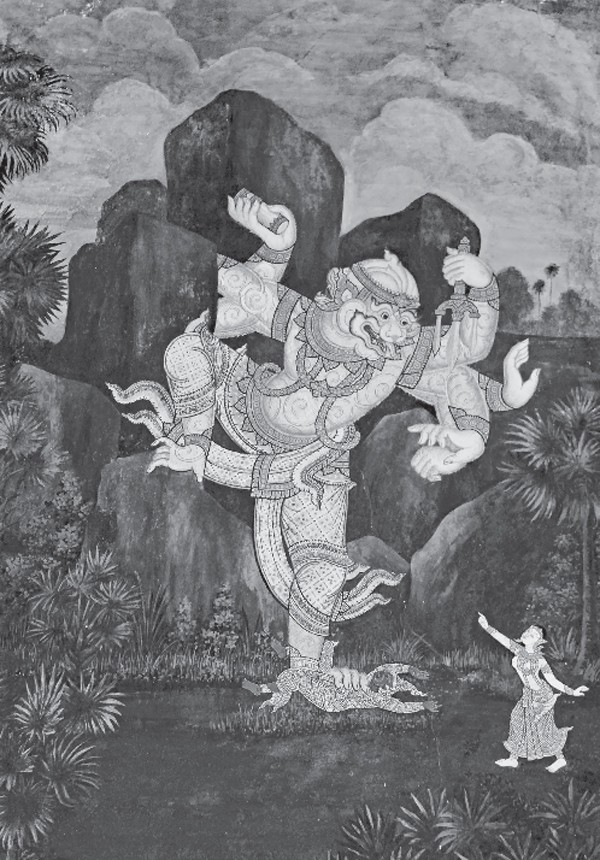CHAPTER 11
ANCIENT GIANTS OF INDIA
As the heat of a fire reduces wood to ashes, the fire of knowledge burns to ashes all karma.
LORD KRISHNA
In 2015 archaeologists in India discovered a group of skeletons from one of the world’s most ancient empires, findings that provide clues about the first human settlements of the Indus Valley Civilization, which appeared around five thousand years ago.1 This was a civilization that extended across India, modern-day Pakistan, and the northeast of Afghanistan. The skeletons were found in a graveyard at Rakhigarhi village in Hisar, a site near the 1934 discovery of a massive ancient giant skeleton as reported in the August 10, 1934, edition of The Argus:
GIANT PREHISTORIC APE—SKELETON 31½ FT. LONG FOUND
The sensational discovery of a skeleton believed to be a prehistoric giant ape, measuring 31 feet 6 inches in length, is reported from Jubbulpore. The discovery was made by a farmer who noticed a bone protruding from the sand on the river bank near the village of Jaintiha. Attempts to dislodge the skeleton with the aid of other villagers failed, whereupon the chief of the State had the skeleton dug out. Three men were required to lift it, the legs alone measuring 10 feet. The skeleton has been placed in the palace of the chief pending examination by geologists, among whom the discovery has created enormous interest. The Jubbulpore district is renowned for its wealth of fossilized relics of an earlier age, the last important discovery three years ago being the remains of a giant prehistoric mammal reputed to be centuries old.2
Some believed these bones to be those of Hanuman, the giant monkey god of Hindu legend. He also left his footprints throughout India, or at least some sort of giant humanoid being did. One of these four-foot-long footprints, which would also make the giant over thirty feet tall, can be seen at a temple in Lepakshi, a small village in Andhra Pradesh.3 Some Hindu and Jain sects believe that Hanuman was not a real ape but a humanlike giant with slight physical variations. Sacred texts from many ancient civilizations describe these giants as hybrids between gods and humans. As we have seen, in the Bible they are called Nephilim. Hanuman can also be classified as a Nephilim because his father was a god and his mother was human.
According to Hindu scriptures, Hanuman was not the only giant that looked like an ape; a whole race of giant apes called the Vanara was documented. Is it possible that this huge skeleton is one of these apelike gods? What happened to Hanuman’s skeleton? Today, we are not able to trace the whereabouts of the thirty-two-foot Rakhigarhi skeleton anywhere. Since India was under British control at that time, this priceless evidence was possibly taken to England, along with many other rare artifacts, and lost down the memory hole like most of the other bones we’ve discussed so far.
There are repeated mentions of these giants in the Hindu holy texts called the Puranas. According to Indian mythology, Brahma created people of such incredible size that large trees were easily uprooted by them once they put their hands around the trunk. The purpose of creating them was to bring order to the world and to also stop the fighting and wicked practices among men. Bhima, mentioned in the Indian epic Mahabharata, happened to be one of the god-sons of Brahma and he also had similar powers and a giant frame. One of the sons of Bhima, Ghatotkacha, was a giant.

Fig. 11.1. Hanuman the monkey god (image by Kru Tony Moore, 2013)

Fig. 11.2. Giant footprint at Lepakshi Temple (photo by Vu2sga, 2012)

Fig. 11.3. Giant footprint at Lepakshi Temple 2 (photo by Pponnada, 2009)
In the Indian epic Ramayana, the chief of the three supreme Hindu gods, Vishnu, was incarnated in a noble family. He fought and defeated the giant Kumbhakarna, the brother of Ravana and Ravana himself, king of the giant rakshasas (demons), whose kingdom was in Sri Lanka.
Sri Lanka, already a mysterious and ancient country, is an island off the coast of southern India, rich with tales of ancient giants. Ten of them once served in the council of the Dutugemunu the Great.4 The giant warrior Nandimitra was considered the strongest Sri Lankan in history and was sent to fight for the Sri Lankan king at the battle of Kahagalagama to secure independence. History records that only two of the original ten giants survived this battle. Possible footprints of these giants can be seen at Adams Peak in central Sri Lanka.